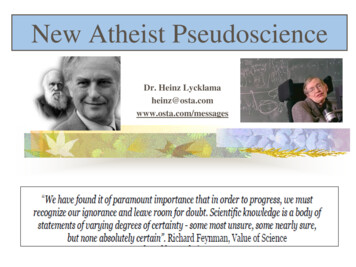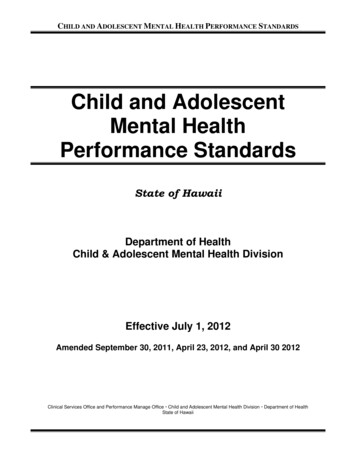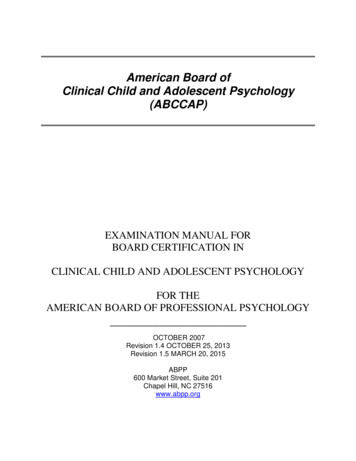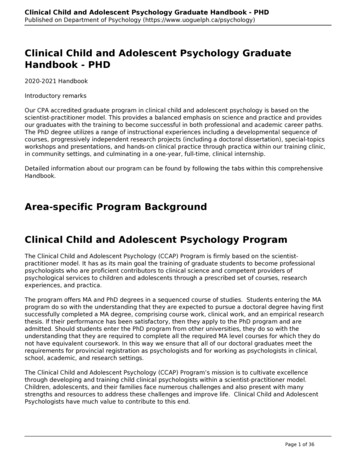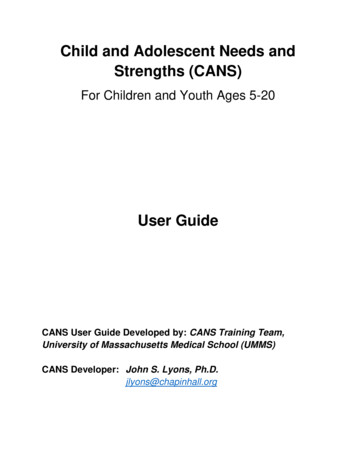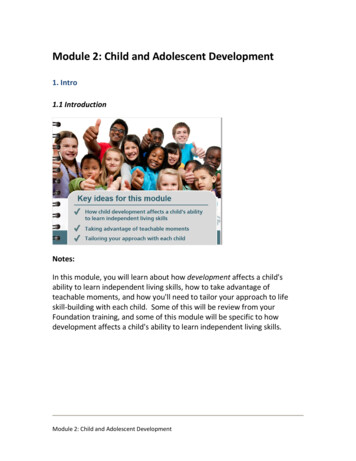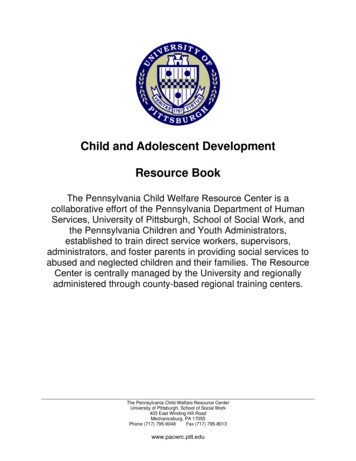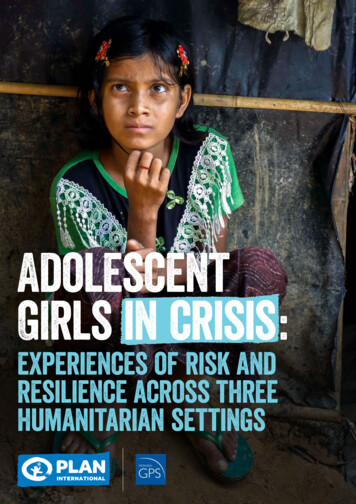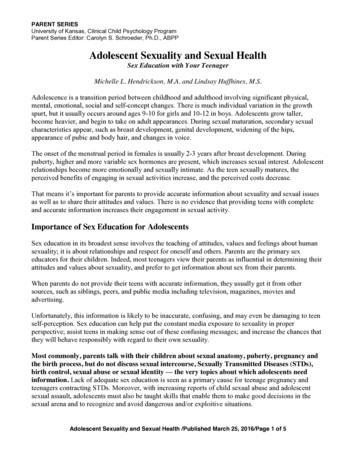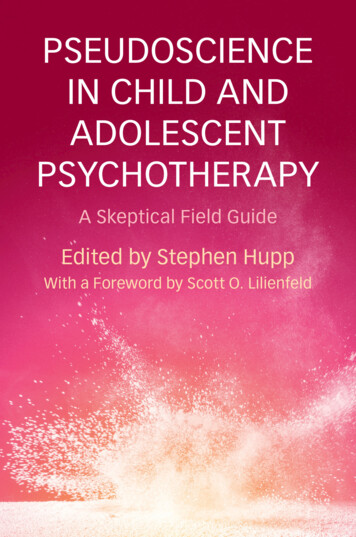
Transcription
Pseudoscience in Child and Adolescent PsychotherapyMost infants, children, and adolescents facing mental health challenges –including autism, psychosis, mania, depression, anxiety, and substance use –do not receive evidence-based treatments. Instead, they commonly receiveineffective and even harmful treatments. In this book, leading experts fromthe fields of clinical psychology, school psychology, developmental psychology, pediatric neurology, applied behavior analysis, and social work identifythe most problematic psychotherapy interventions used for each mentalhealth issue. In addition to these primary authors, each chapter includesa sidebar from a specialist representing the disciplines of pediatrics, anthropology, neuroscience, and psychology. The contributors work in academia,hospitals, and private practice and include book authors, podcasters, andeven a filmmaker. Not only does this book highlight the threats of potentiallyharmful pseudoscience, it also summarizes treatments that actually havea strong evidence base and deliver far more positive results.Stephen Hupp is Professor of Psychology in the Clinical Child and SchoolPsychology program at Southern Illinois University Edwardsville (SIUE),USA, and a licensed clinical psychologist. His other books include GreatMyths of Child Development (2015), Great Myths of Adolescence (2019), andThinking Critically About Child Development, 4th edition (forthcoming,2020). In 2015, he won the Great Teacher Award from the SIUE AlumniAssociation. He is also an executive producer for the Science Moms documentary, and he holds the Guinness World Record for the “longest lineof books.” On Twitter he is @StephenHupp.
Pseudoscience in Childand AdolescentPsychotherapyA Skeptical Field GuideEdited byStephen HuppSouthern Illinois University Edwardsville
University Printing House, Cambridge CB2 8BS, United KingdomOne Liberty Plaza, 20th Floor, New York, NY 10006, USA477 Williamstown Road, Port Melbourne, VIC 3207, Australia314–321, 3rd Floor, Plot 3, Splendor Forum, Jasola District Centre,New Delhi – 110025, India79 Anson Road, #06–04/06, Singapore 079906Cambridge University Press is part of the University of Cambridge.It furthers the University’s mission by disseminating knowledge in the pursuit ofeducation, learning, and research at the highest international levels of excellence.www.cambridge.orgInformation on this title: www.cambridge.org/9781107175310DOI: 10.1017/9781316798096 Cambridge University Press 2019This publication is in copyright. Subject to statutory exceptionand to the provisions of relevant collective licensing agreements,no reproduction of any part may take place without the writtenpermission of Cambridge University Press.First published 2019Printed and bound in Great Britain by Clays Ltd, Elcograf S.p.A.A catalogue record for this publication is available from the British Library.Library of Congress Cataloging-in-Publication DataNames: Hupp, Stephen, editor.Title: Pseudoscience in child and adolescent psychotherapy : a skeptical field guide /edited by Stephen Hupp.Description: New York : Cambridge University Press, 2019.Identifiers: LCCN 2018042306 ISBN 9781107175310 (hardback) ISBN 9781316626955 (paperback)Subjects: LCSH: Child psychotherapy. Adolescent psychotherapy BISAC: PSYCHOLOGY / Clinical Psychology.Classification: LCC RJ504 .P7325 2019 DDC 618.92/8914–dc23LC record available at https://lccn.loc.gov/2018042306ISBN 978-1-107-17531-0 HardbackISBN 978-1-316-62695-5 PaperbackCambridge University Press has no responsibility for the persistence or accuracy ofURLs for external or third-party internet websites referred to in this publicationand does not guarantee that any content on such websites is, or will remain,accurate or appropriate.
To my dad, Dennis Hupp, for being my best and biggest mentor
ContentsList of SidebarsList of ContributorsForewordpage ixxixvScott O. LilienfeldPrefaceAcknowledgments1 Critical Thinking about Psychotherapyxixxxii1Stephen Hupp, Jean Mercer, Bruce A. Thyer, and Monica Pignotti2 Intellectual and Adaptive Functioning14Elizabeth M. Kryszak, Jessica F. Scherr, and James A. Mulick3 Autism Spectrum28Jessica F. Scherr, Elizabeth M. Kryszak, and James A. Mulick4 Inattention and Hyperactivity50Christine A. Lee and Richard Milich5 Learning66Zachary LaBrot and Brad Dufrene6 Tics80Michael B. Himle and Brianna Wellen7 Psychosis96Rachel Waford and Carina A. Iati8 Bipolar Spectrum110Guillermo Pérez Algorta and Eric Youngstrom9 Depression124Thomas J. Huberty10 AnxietyBruce A. Thyer and Monica Pignotti140
viiiContents11 Obsessions and Compulsions159Monica Pignotti and Bruce A. Thyer12 Trauma and Attachment172Jean Mercer13 Feeding189Linda J. Cooper-Brown, Mary Louise E. Kerwin,and Keith E. Williams14 Eating206Frances Bozsik, Brooke L. Bennett, Emily Stefano,Brooke L. Whisenhunt, and Danae L. Hudson15 Toileting225Michael I. Axelrod and Joseph P. Deegan16 Sleep243Stephanie Jackson and Sarah Morsbach Honaker17 Disruptive Behavior and Conduct260Jeremy Jewell, Madison Schoen, Sydney Thompson,Emily Fischer, and Sarah Conoyer18 Substance Use276Mariann Suarez19 Skepticism and Psychotherapy291Stephen Hupp and Kathleen DyerIndex302
Sidebars1What is Guerrilla Skepticism on Wikipedia?page 6Susan Gerbic2Does craniosacral therapy improve cognitive functioning?22Jason Travers3Does Dolphin-Assisted Therapy have healing effects?37Lori Marino and Scott O. Lilienfeld4Does brain balancing improve attention?57Christian Jarrett5Should children be taught based on their preferred learningstyle?68Indre Viskontas6Can a dental device decrease tics?89Grant Ritchey and Clay Jones7Is homeopathy effective for schizophrenia?105Michael Marshall8Does naturopathic medicine help treat bipolar disorder?9Is psychoanalytic dream interpretation useful?115Britt Hermes133Caleb W. Lack10Should children be afraid of Bigfoot?141Carol E. Colaninno11Do superstitious rituals help cope with anxiety?160Stuart Vyse12Does attachment parenting promote attachment?176Amy Tuteur13Should parents avoid feeding their children GMOs?196Natalie Newell14Is it possible for breatharians to live without food or water?211Joe Nickell15Does self-acupressure work for constipation?233Harriet Hall16Do aliens abduct people while they are sleeping?250W. Blake Smith17Is lying always a sign of psychological problems?Robert S. Feldman261
xList of Sidebars18Are specialized goggles effective at preventing impaireddriving?282Miranda Meeker and LeAnna Kehl19aWhat is gay conversion therapy?292Sheldon W. Helms19bShould children be taught about pseudoscience?Henry Hupp299
ContributorsGuillermo Pérez Algorta, PhD, Lecturer in Mental Health, Division ofHealth Research, Faculty of Health and Medicine, Lancaster University,United Kingdom.Michael I. Axelrod, PhD, Professor, Psychology Department, Universityof Wisconsin – Eau Claire. Author of Behavior Analysis for SchoolPsychologists (2017).Brooke L. Bennett, MS, Doctoral candidate, Department of Psychology,University of Hawai’i at Mānoa.Frances Bozsik, MS, Doctoral candidate, Department of Psychology,University of Missouri – Kansas City.Sarah Conoyer, PhD, Assistant Professor, Department of Psychology,Southern Illinois University Edwardsville.Linda J. Cooper-Brown, PhD, Clinical Associate Professor of Pediatrics,The University of Iowa, Iowa City. Director, Pediatric PsychologyFeeding Disorders Service, University of Iowa Stead Family Children’sHospital.Joseph P. Deegan, MSE, School psychology graduate student,University of Wisconsin – Eau Claire. District Assessment Coordinatorfor the School District of Marinette, Wisconsin.Brad Dufrene, PhD, Professor, Department of Psychology, University ofSouthern Mississippi, Hattiesburg.Kathleen Dyer, PhD, Associate Professor of Child and Family Science,California State University, Fresno. Author of An Introduction toEffective Parenting Education (2017).Emily Fischer, BS, Graduate student, Department of Psychology,Southern Illinois University Edwardsville.Michael B. Himle, PhD, Associate Professor, Department ofPsychology, University of Utah. Co-director of the TouretteAssociation of America Designated Center of Excellence for Touretteand Tic Disorders.
xiiList of ContributorsSarah Morsbach Honaker, PhD, CBSM, Assistant Professor ofPediatrics, Indiana University School of Medicine, Director ofBehavioral Sleep Medicine at Riley Children’s Hospital, Indianapolis.Thomas J. Huberty, PhD, ABPP, Professor Emeritus, Counseling andEducational Psychology, Indiana University Bloomington. Author ofAnxiety and Depression in Children and Adolescents: Assessment,Intervention, and Prevention (2012).Danae L. Hudson, PhD, Professor, Department of Psychology, MissouriState University. Co-author of Revel Psychology, 1st edition (2019).Stephen Hupp, PhD, Professor, Department of Psychology, SouthernIllinois University Edwardsville. Co-author of Great Myths of ChildDevelopment (2015).Carina A. Iati, PsyD, Clinical Psychologist, Tewksbury Hospital,Massachusetts. Co-author of The Psychosis Response Guide: How toHelp Young People in Psychiatric Crises (2016).Stephanie Jackson, MD, Assistant Professor of Clinical Pediatrics,Indiana University School of Medicine, Indianapolis.Jeremy Jewell, PhD, Professor, Department of Psychology, SouthernIllinois University Edwardsville. Co-author of Great Myths ofAdolescence (2019).Mary Louise E. Kerwin, PhD, BCBA-D, Department Head andProfessor, Department of Psychology, Rowan University, Glassboro,New Jersey. Executive Director, Center for Behavior Analysis, RowanUniversity.Elizabeth M. Kryszak, PhD, Psychologist, Child Development Center,Nationwide Children’s Hospital.Zachary LaBrot, PhD, Assistant Professor, Department of Psychology,University of Nebraska Medical Center, Munroe-Meyer Institute,Omaha, Nebraska.Christine A. Lee, MS, Doctoral candidate, Psychology Department,University of Kentucky, Lexington.Scott O. Lilienfeld, PhD, Professor, Department of Psychology, EmoryUniversity, Atlanta, Georgia. Co-editor of Science and Pseudoscience inClinical Psychology, 2nd edition (2014).
List of ContributorsxiiiJean Mercer, PhD, Professor Emerita of Psychology, StocktonUniversity, Galloway, New Jersey. Author of Thinking Critically AboutChild Development, 3rd edition (2016).Richard Milich, PhD, Professor, Department of Psychology, Universityof Kentucky, Lexington.James A. Mulick, PhD, Emeritus Professor of Pediatrics, The Ohio StateUniversity.Monica Pignotti, PhD, Independent Scholar, Tallahassee, Florida andAustin, Texas. Co-author of Science and Pseudoscience in Social WorkPractice (2015).Jessica F. Scherr, PhD, Postdoctoral Psychology Fellow, ChildDevelopment Center, Nationwide Children’s Hospital.Madison Schoen, MS, Doctoral candidate, University of Missouri,Columbia.Emily Stefano, MS, Doctoral candidate, Department of Psychology,University of Hawai’i at Mānoa.Mariann Suarez, PhD, ABPP, Associate Professor, Psychiatry andBehavioral Neurosciences USF Health, Morsani College of Medicine,Tampa, Florida. Co-author of Motivational Interviewing withAdolescents and Young Adults (2011).Sydney Thompson, MS, Doctoral candidate, Chicago School ofProfessional Psychology, Illinois.Bruce A. Thyer, PhD, LCSW, BCBA-D, Distinguished Research Professor,College of Social Work, Florida State University, Tallahassee. Co-author ofScience and Pseudoscience in Social Work Practice (2015).Rachel Waford, PhD, Assistant Professor, Department of Psychiatry andBehavioral Sciences, Emory University, Atlanta, Georgia. Co-author ofThe Psychosis Response Guide: How to Help Young People in PsychiatricCrises (2016).Brianna Wellen, BS, Graduate student, Department of Psychology,University of Utah.Brooke L. Whisenhunt, PhD, Professor, Department of Psychology,Missouri State University. Co-author of Revel Psychology, 1st edition(2019).
xivList of ContributorsKeith E. Williams, PhD, BCBA, Professor of Pediatrics, Penn StateCollege of Medicine, Director, Feeding Program, Penn State HersheyMedical Center.Eric Youngstrom, PhD, Professor, Department of Psychology andNeuroscience, University of North Carolina at Chapel Hill. ActingDirector for the Center for Excellence in Research and Treatment ofBipolar Disorder.
ForewordThe Road to Hell Is Paved with PseudoscientificTechniquesScott O. LilienfeldWhen it comes to helping others with psychological problems, goodintentions are essential. Still, as this immensely valuable volume editedby Stephen Hupp amply illustrates, good intentions are not sufficient.The history of medicine, including psychiatry, is a sobering reminder thateven the best-meaning practitioners can do terrible harm. Most historians of medicine maintain that until about 1890, the substantial majorityof physical procedures were useless or iatrogenic (Grove & Meehl, 1996).In the early twenty-first century, it is all too easy to forget that fordecades or even centuries, such since-debunked interventions as bleeding, blistering, purging, leeching, bloodletting, spinning, and the likewere widely accepted by many practitioners as effective for the treatmentof mental disorders (Gambrill, 2012). Today, these “treatments” understandably strike most of us as barbaric and inhumane. Yet almost certainly, the health care providers who provided them were convinced thattheir nostrums were helpful. They meant well.Yes, outright charlatans exist in mental health, and the sprawlingdiscipline of child and adolescent psychological and psychiatric treatment is no exception. Nevertheless, deliberate snake oil salespersons arefew and far between. Most of the practitioners of the dubious techniquessurveyed in this remarkably comprehensive volume mean well, much asdid past purveyors of bleeding, blistering, and the like. And most of thesepractitioners are almost surely convinced that their preferred ministrations work. Why?The reason is that they rely largely on their clinical intuitions andinformal clinical observations, both of which can often be helpful forgenerating fruitful hypotheses but which tend to be woefully ill suited toascertaining whether treatments work. For this crucial task, we must turnto scientific methods, which are partial bulwarks against confirmationbias, the deeply entrenched tendency – to which we are all prone – toseek out, interpret, and recall evidence consistent with our hypothesesand to deny, dismiss, or distort evidence that is not (Nickerson, 1998;
xviForewordTavris & Aronson, 2008). In the domains of mental health treatmentresearch, such methods encompass randomized controlled trials; systematic within-subject designs; and when these are not feasible, wellcontrolled case control designs (Lilienfeld, Ritschel, Lynn, Cautin, &Latzman, 2014). None of these designs is a panacea, but each affordsa much-needed check against regression to the mean, placebo effects,multiple treatment interference, and a plethora of other sources ofspurious therapeutic effectiveness (Lilienfeld, McKay, & Hollon, 2018).In this respect, these designs are also critical safeguards against our ownpropensity to dupe ourselves into believing that our favored interventions work when they do not. As the late Robert Pirsig (1974) wrote in hisclassic book, Zen and the Art of Motorcycle Maintenance, “the realpurpose of the scientific method is to make sure nature hasn’t misledyou into thinking you know something you actually don’t know” (p. 108).Early in the course of their training, many clinicians may somehow finda scientific approach to clinical practice to be impersonal or heartless.“I don’t want to learn about research; I just want to help people,” theymay think. Even some experienced practitioners may at times lapse intothis fallacious reasoning. Nevertheless, one must be careful not to confuse hard-headedness with hard-heartedness (Meehl, 1973). Beinga rigorous thinker is not incompatible with being a caring professional.To the contrary, a genuinely humane approach to practice demands theuse of scientific methods, because these methods are ultimately our besthope for minimizing errors in our clinical inferences, including treatmentdecisions (McKay, 2017).As soon as we believe ourselves to be immune to error in clinicalsettings, we are operating with intellectual hubris. In contrast, the adoption of a scientific approach embodies the attitude of intellectual humility, which mandates a willingness to acknowledge the possibility that wemight be mistaken (see also Leary et al., 2017). As astrophysicist andscience writer Carl Sagan (1995) noted, good scientists always heara little voice in their heads that incessantly intones “you might bewrong.” The same principle holds for clinical scientists, whether theyare functioning in the therapy room, laboratory, or classroom.In an influential but controversial recent book, Paul Bloom (2017)argued that empathy, which he defines as experiencing the same emotions as the person with whom one is identifying, is unhelpful and oftenharmful, as it tends to lead to a loss of perspective. Instead, Bloommaintained, we should strive to cultivate what he terms rational compassion, in which we combine caring with a dispassionate view of reality. Allgood surgeons understand this principle. They need to retain their
Forewordxviiconcern for their patients, of course, but they also need to distancethemselves appropriately from their emotions in the long-term serviceof helping. The merits or lack thereof of Bloom’s specific argumentsnotwithstanding, the overarching point remains. Science is not theenemy of caring; it is its best friend.As you read the chapters of this important volume, remember thatvirtually all advocates of the bewildering panoply of unsupported clinicaltechniques discussed within its pages sincerely want to help.Furthermore, almost all of them believe that they are helping. Yet inmany or most cases, they are being fooled or more precisely, foolingthemselves.These practitioners are owed some of the blame, to be sure, but evenmore of the blame goes to the allied disciplines of mental health, such aspsychology, psychiatry, psychiatric nursing, social work, and counseling,for not doing a better job of inculcating scientific thinking in theirstudents. In this respect, this book is a crucial corrective: it isa wonderful resource for how to think clearly about childhood andadolescent mental health problems and their treatment. In addition,this book is a powerful antidote against the seductive temptations ofpseudoscience. It reminds us that the impetus to help is by itself futile.It must be fused with an impetus to understand the human mind using thebest available scientific methods.ReferencesBloom, P. (2017). Against empathy: The case for rational compassion. New York:Random House.Gambrill, E. (2012). Social work practice: A critical thinker’s guide. New York:Oxford University Press.Grove, W. M., & Meehl, P. E. (1996). Comparative efficiency of informal (subjective, impressionistic) and formal (mechanical, algorithmic) predictionprocedures: The clinical–statistical controversy. Psychology, Public Policy,and Law, 2, 293–323.Leary, M. R., Diebels, K. J., Davisson, E. K., Jongman-Sereno, K. P.,Isherwood, J. C., Raimi, K. T. . . . & Hoyle, R. H. (2017). Cognitive andinterpersonal features of intellectual humility. Personality and SocialPsychology Bulletin, 43, 793–813.Lilienfeld, S. O., McKay, D., & Hollon, S. D. (2018). Why randomized controlledtrials of psychological treatments are still essential. Lancet Psychiatry, 5,536–538.
xviiiForewordLilienfeld, S. O., Ritschel, L. A., Lynn, S. J., Cautin, R. L., & Latzman, R. D.(2014). Why ineffective psychotherapies appear to work: A taxonomy ofcauses of spurious therapeutic effectiveness. Perspectives on PsychologicalScience, 9, 355–387.McKay, D. (2017, December 16). Compassionate evidence-based treatment.Psychology Today Blogs. iesMeehl, P. E. (1973). Why I do not attend case conferences. In P. E. Meehl (ed.),Psychodiagnosis: Selected papers (pp. 225–302). Minneapolis: University ofMinnesota Press.Nickerson, R. S. (1998). Confirmation bias: A ubiquitous phenomenon in manyguises. Review of General Psychology, 2, 175–220.Pirsig, R. M. (1974). Zen and the art of motorcycle maintenance: An inquiry intovalues. New York: Random House.Sagan, C. (1995). The demon-haunted world: Science as a candle in the dark.New York: Random House.Tavris, C., & Aronson, E. (2008). Mistakes were made (but not by me): Why wejustify foolish beliefs, bad decisions, and hurtful acts. Boston: HoughtonMifflin Harcourt.
PrefaceMost other books about psychotherapy emphasize everything you needto learn. This is one of the rare books to focus on what you’d be better offto avoid learning. If fact, I’d be delighted if you never really learnedanything described within. Unfortunately, I’ve come to realize that without knowing it, you and I have already learned much about great myths,fads, fallacies, frauds, and hoaxes. And so now we must take a moment toconsider pseudoscience and other questionable ideas related topsychotherapy.The goal is for this book to stand alone as a resource. That is, eventhough it was developed in tandem with a related book called Child andAdolescent Psychotherapy (Hupp, 2018), you can still hope to get plentyout of this book without also reading its companion. Reading bothtogether has its advantages, but this book could actually serve asa companion book to any of the other excellent books about psychotherapy with youth.This book has a few unique attributes. First, the coverage isbroad. Second, the organization of topics mirrors the Diagnostic andStatistical Manual. Finally, in addition to chapters by many of the topscholars in the field of psychology, this book includes multidisciplinarycontributions from the fields of science communication and skepticism.Unique AttributesThis book is a skeptical field guide to be included in graduate and undergraduate courses related to child and adolescent psychology. Specifically,it supplements readings about evidence-based approaches in coursesrelated to Psychotherapy, Counseling, Behavior Therapy, and evenPsychopathology. Therapists who work with youth can also use thisbook as a starting point for learning more about pseudoscience.Parents may also benefit from reading about these topics.Broad CoverageThis book was designed to have very broad coverage in a few differentways:
xxPreface Types of pseudoscience and questionable ideas. This book includesmany treatment approaches that are problematic in different ways,and it also covers other areas that influence treatment. For their topic,the chapter authors were asked to consider the following issues: implausible treatments ineffective treatments potentially harmful treatments diagnostic controversies questionable assessment practices myths that influence treatment undermining evidence-based approaches Topic selection and age range. This book covers a wide range of topicsthat mirror the same topics from Child and Adolescent Psychotherapy,which includes a broader coverage of topics than that found in mostother similar books. This book also covers everything from infancythrough adolescence.Expert ContributorsPerhaps the greatest strength of this book is the lineup of contributors.If you don’t recognize most of these names, now is the perfect time tostart getting to know them!Expert chapter authors. Our Foreword contributor really sets the stagefor a star-studded lineup of psychological skepticism. All these authorsregularly publish articles in top-tier academic journals, and several contributors have published influential books, some of which inspired thedevelopment of this book. Many chapter authors are in academia, whileothers work in hospitals or private practice. The represented fields of thechapter authors include clinical psychology, school psychology, developmental psychology, applied behavior analysis, pediatrics, and socialwork. A few students also chipped in and will likely continue the fightfor evidence-based practices long into the future.Sidebars from interdisciplinary science communicators. In addition tothe experts who wrote each of the chapters, each chapter includesa sidebar written by a prominent science communicator. These sidebarauthors come from fields including pediatrics, dentistry, obstetrics,anthropology, neuroscience, and psychology. Most of these authors arewell known in the skeptical community, and many of them regularlycontribute to skeptical magazines, blogs, and websites. Several of the
PrefacexxiSidebar contributors have written books or developed podcasts, and oneeven developed, directed, and produced a skeptical film!Sidebar topics were selected to integrate well with the material in eachchapter. It’s important to note here, though, that in nearly all cases thechapter authors and the sidebar authors worked independently. That is,the views of the chapter authors do not necessarily reflect the views of thesidebars’ authors (and vice versa).
AcknowledgmentsIn the first proposal of this project, there was only going to be one bookthat covered both evidence-based approaches and pseudoscientific ones.Fortunately, Matt Bennett saw the value in expanding to two books, andI am very thankful for his foresight. Other Cambridge staff who deservecredit for all they did during the development of this book includeBrianda Reyes, Stephen Acerra, Emily Watton, Grace Morris, andDavid Repetto. Linda Benson from Integra also provided some heavylifting toward moving the book to final publication. I can’t give enoughthanks to Scott O. Lilienfeld for helping to give me a big break and forcontinuing to support my work through his additions to this book. I’vehad a lot of academic mentors who taught me so much about criticalthinking, and they include David Reitman, Kathleen Lemanek, WilliamPelham Jr., C. Daniel Batson, C. R. Snyder, John Northup, Mary LouKelley, Keith D. Allen, Mark Shriver, and Emily Krohn. Thanks also tothe chapter authors and the sidebar authors who all provided amazingcontributions.I’m also very thankful for my family, especially Vyla, Evan, Henry, andmy fiancée Farrah who works diligently to keep me from being tooskeptical. The dedication for this book went to my father, DennisHupp, and for the companion book went to my mom, Deanna Hupp,who both have continued to always be there for me, our family, and eachother.
1Critical Thinking about PsychotherapyStephen Hupp, Jean Mercer, Bruce A. Thyer, and Monica PignottiWe’ll give you the good news first – multiple evidence-based treatments(EBTs) have been identified for most psychological challenges thatchildren and adolescents face, and the Society of Clinical Child andAdolescent Psychology, also known as Division 53 of the AmericanPsychological Association, has been at the forefront of identifyingEBTs for youth (the term “youth” will be used throughout this book torepresent both children and adolescents, and sometimes even infants).As you glance through the chapter titles of this book, you should knowthat authors writing on these same topics in the companion book, entitledChild and Adolescent Psychotherapy (Hupp, 2018), were able to findresearch-supported approaches to treating all of these topics. In somecases, the treatments are well established, meaning they have at least twowell-designed studies by different research teams. In other cases, theresearch is not quite as strong, but there’s enough to give any cliniciana good starting point for conducting therapy. Admittedly, no treatmentworks for everyone. Moreover, even when a treatment does help a childimprove psychological functioning, the child may still continue to experience some symptoms over time. That is to say, the science of clinical childand adolescent psychology is not perfect, is not complete, and is notfinished moving forward.Now for the bad news – the science of clinical child and adolescentpsychology is not being utilized to its fullest. Not even close. Despitehaving access to information about which treatments have solid researchsupport, many therapists are not using these treatments. Even worse,they are frequently using treatments that have already been shown to beineffective (Lilienfeld, 2005; Lilienfeld, Ammirati, & David, 2012).In fact, one study identified 63 ineffective treatments for youth thathave been discredited in a Delphi poll with experts (Koocher et al.,2015). Ineffective treatments are problematic because they (a) wastetime, (b) cost money, (c) damage the credibility of therapists, and (d)may cause considerable harm to youth and their parents. The use of
2Hupp, Mercer, Thyer, and Pignottiineffective treatments is also disconcerting when considering the strongliterature in support of several evidence-based approaches. With somany valuable treatments available, there is no good reason to usea treatment that has been shown to be ineffective, especially if it hasbeen shown to be harmful.1.1 Pseudoscience and Questionable IdeasSome practitioners continue to argue that an ineffective treatmentworks, often relying on poorly designed studies to bolster their arguments, even after well-designed studies show the treatment is ineffective.Other times practitioners grossly misinterpret the results of other studiesas a way to support their use of an ineffective treatment. Both cases areexamples of engaging in pseudoscience. Although pseudoscience hasbeen said to be a “fuzzy” term (McNally, 2003), a more formal definitionwas offered by the philosopher of science Mario Bunge as “a body ofbeliefs and practices whose practitioners wish, naively or maliciously,pass for science although it is alien to the approach, the techniques, andthe fund of knowledge of science” (Bunge, 1998, p. 41). In essence,pseudoscientific practices give the superficial appearance of science,using scientific-sounding jargon borrowed from legitimate science, yetlacking the substance of having valid scientific r
Psychology program at Southern Illinois University Edwardsville (SIUE), USA, and a licensed clinical psychologist. His other books include Great nce(2019),and Thinking Critically About Child Development, 4th edition (forthcoming, 2020). In 2015, he won the Great Teacher Award from the SIUE Alumni Association. He is also an executive producer .
